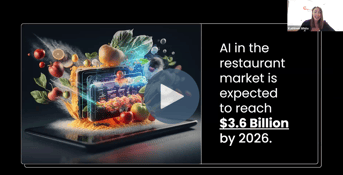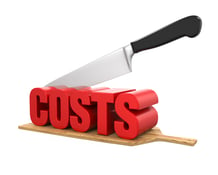If you’re wondering if your customers are interested in takeout, know that 86% of diners order delivery at least once a month, if not more. Offering takeout and delivery has never been more lucrative for restaurants, but there are a lot of factors that go into developing a profitable to-go program. Here are our insights for why and how to start offering takeout options at your restaurant.
Why offer delivery and takeout?
Aside from the fact that there is strong consumer demand, there are a number of other benefits to offering to-go options:
Higher profits. 60% of operators say that offering off-premise options has increased their sales, while 20% of consumers also say they tend to spend more on takeout orders. This means more revenue for your restaurant.
Wider reach. Local regulars are wonderful, but with delivery or takeout, you can reach a whole new segment of customers who are a little farther away. 87% of restaurants offering to-go services report an increase in new customers.
More data. As you start to expand your offerings, you can see what people are ordering to-go and what areas they are living in. It’s this type of data that helps you improve your menu and maybe even open a second location.
What's the best technology to use?
As of this year, online ordering is predicted to become a $38 billion industry. With potential profits like that, it’s no wonder so many companies have gotten into the delivery and takeout game. Yes, you can do ordering the old fashioned way over the phone or with in-person orders, but if you are interested in technology options that can potentially help you optimize your ordering program, take a look at what’s out there.
Online Ordering Only
Point of Sale (POS) Systems A POS system is a common fixture at restaurants, serving as the hub for all payments and transactions. In addition, many POS like Toast, Upserve, Revel, or Shopkeep have built-in online ordering and takeout functionality.
Takeout Only Apps If you are primarily focused on takeout then look into hospitality-specific options like Swipe.by and SkyTab. Joining these apps will put your restaurant in front of new faces and manage pickup logistics for you.
Mobile Payment Providers Mobile payment providers like Square (which also has a POS option) provide another alternative for restaurant online ordering. Square offers restaurants a web-based, mobile store that works best for online ordering centered around shelf-stable goods.
Delivery
Turn-key step up These delivery apps function by having their own platform that consumers interact with directly. Restaurants are then charged a commission fee for the service and are provide a workforce to get food to a customer’s door. The restaurant also uses its own portal to the app to manage the deliveries. Examples of these services include Grub Hub, Door Dash and Uber Eats.
Full-service options 70% of consumers prefer to order directly through a restaurant, and white label delivery providers like Olo, ChowNow and Onfleet make that more possible. They offer online ordering options that are native to your restaurant’s website or in mobile app form. Usually requiring a bigger tech investment, they function on a monthly subscription fee and coordinate a delivery fleet for you as well.
Picking the right online ordering service
As you can already tell, not all ordering platforms are created equal. They each offer specific advantages based on your restaurant type, size and operations. Here are some key things to look for as you shop around:
What are the commission fees? Some apps can charge up to 30% in commission fees. That type of charge will eat the majority of your profit margins. Make sure you pick a platform that is going to help drive revenue, otherwise you are just treading water.
What are the markups? Depending on the delivery option, your customer could be paying up to 91% more for your food than if they had just ordered from you directly. These markups can detour repeat customers.
Will you have control of your listing and data? Will you be able to make changes easily, communicate with your customers and have access to their information? If not, the third-party provider is owning that relationship. You wouldn’t stand for it in your restaurant. Don’t stand for it online either
What additional tech will you need? See if you will need to buy in additional, physical tech to use the platform. Also, be sure to ask how long it will take to build all tech components out to get your restaurant’s online ordering live. Note: If you end up using more than one takeout option be weary of tablet farms cropping up in your restaurant. They will require extra training procedures to avoid order confusion.
How does it integrate with your POS? When it comes to tech, most restaurants want an all-in-one system. However, if that is not possible, make sure that your takeout option is able to communicate and integrate with your POS. It will help you manage inventory and orders with much more ease.
What notifications does it offer? Communication with these programs is everything. Make sure you explore what notifications will look like from everything to an order coming in, to how your tickets in the kitchen are triggered, to your driver picking up and your guest knowing it’s coming.
What is this company’s general reputation? Let’s face it, over the past few years there have been lots of examples of delivery services behaving badly. Align yourself with a platform who’s values reflect your own and you can’t go wrong!
How to set up restaurant takeout & delivery
Once you’ve decided what delivery or takeout platform you want to use, it’s time to start cooking with gas. Take these steps into account when setting up your own program for online ordering:
Evaluate your food for what will be best for delivery. Factors to help you narrow down the menu: customer favorites, dishes with higher profit margins, food that travels well, food that can be prepared well and quickly by your kitchen. (Pro tip: Offer online-only menu items to incentivize more takeout sales.)
Make sure you have the right packaging for delivery. You’ll want breathable material so food doesn’t get soggy. If the food is spoiled by the packaging, don’t offer it to-go.
Have set areas for takeout prep, packaging and pickup so these orders don’t get mixed up with in-person orders.
Designated a dedicated employee to manage all delivery and takeout orders. Having this point person will create more structure and enhance communication.
Double-check everything. Either the person managing orders or an assistant on staff should be confirming that the right food is going to the right order before pick up.
Train your staff and have set procedures they can refer to easily. Training should include technical dry runs to make sure your platforms are working correctly and delivery experiments so you know how your food is holding up. Do not launch takeout or delivery without a soft, trail “opening” to work out the kinks.
Working with third-party couriers
If you do not have a delivery force of your own, then you will be working directly with the couriers your takeout or delivery app is providing you. These couriers are the lifeblood of delivery services, often traversing all over the city, delivering multiple orders for different restaurants in one swing. Here are some best practices to keep in mind to have the best relationship with your couriers:
Always attach a receipt or invoice to your order so it’s clear not only to you but to the courier who the delivery is for.
When a courier arrives, ask for the name on the order they are picking up. Again, this prevents confusion.
The structural integrity of your delivery should not be additional stress for your courier. Make sure bags and packaging can handle being carried and moved around without incident.
Sometimes couriers are on a bike and it is more difficult for them to enter your establishment. Be willing to walk things out to them. It just means the food will get there faster.
Be kind! Treat them like any guest or esteemed employee. Let them use your bathroom. Offer them water. They may not be your direct employee, but they sure are helping your business succeed. Being nice goes a long way.
[Photo: Kai Pilger via Unsplash]





